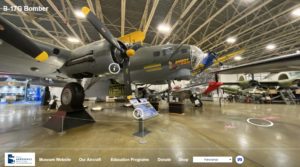 With the latest trends and newest technologies, society is changing with each new day. However, there is one field that might be falling behind: museums. Like their collections, museums may sadly become archaic and “out-of-date” with the future. There will always be those who love history and visiting museums, but for the population who is growing up in a digital world, how do museums keep up? The answer is digitization. Digitization is the process of taking physical objects, such as photographs, documents and artifacts, and converting them into a digital format viewable on a computer, tablet or mobile device.
With the latest trends and newest technologies, society is changing with each new day. However, there is one field that might be falling behind: museums. Like their collections, museums may sadly become archaic and “out-of-date” with the future. There will always be those who love history and visiting museums, but for the population who is growing up in a digital world, how do museums keep up? The answer is digitization. Digitization is the process of taking physical objects, such as photographs, documents and artifacts, and converting them into a digital format viewable on a computer, tablet or mobile device.
What is Hill Aerospace Museum doing to move forward into the future through digitization? Within the last year, Hill Aerospace Museum has invested in the latest 3D and virtual technologies to create 3D models of artifacts and virtual tours of the aircraft. How does Hill Aerospace Museum create its 3D models and virtual tours? When creating 3D models, museum staff take dozens of photographs of an artifact from different angles. They then stitch and layer the photos together to create a 3D model. This is a scientific process called photogrammetry. Once online, users can move the object around and handle it as if they were holding it in real life.
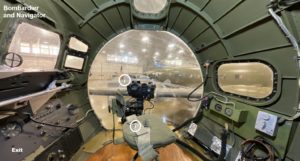 When creating virtual airplane tours, museum staff use a camera to capture 360-degree pictures of the outside and inside of the aircraft. These photos are then loaded into a virtual tour software program that stitches the photos together to create a virtual landscape. Viewers can walk through the area as if they were there in person. Additionally, museum staff are able to add historical information, labels, photographs and videos for users to view.
When creating virtual airplane tours, museum staff use a camera to capture 360-degree pictures of the outside and inside of the aircraft. These photos are then loaded into a virtual tour software program that stitches the photos together to create a virtual landscape. Viewers can walk through the area as if they were there in person. Additionally, museum staff are able to add historical information, labels, photographs and videos for users to view.
What is the purpose of digitizing artifacts and airplanes? What benefits does it give to Hill Aerospace Museum and its in-person and online visitors? One of the main purposes and benefits of digitizing a museum’s collection is the increased preservation and extended lifetime of an artifact. When a museum digitizes an artifact, it is permanently online for anyone to see, including curators. This means curators no longer have to pull out an artifact from storage and handle it every time they need it. Even handling an artifact with great care and experience takes a toll. When an artifact is digital, a curator can still work, study and interpret the object, all while the artifact is safely preserved in storage. Physically preserving artifacts maintains the historical value and authenticity, while digitally preserving it extends that value further into the future.
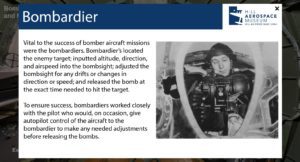 Another great benefit of digitizing a museum’s collection is greater accessibility to the public. This a big benefit for Hill Aerospace Museum! For most of the year, the museum closes the aircraft from public access for preservation purposes. Creating virtual aircraft tours allows online visitors to “walk” through the aircraft and see sections that guests normally aren’t allowed to view. Take the virtual tour of our B-17, for example. The interior is closed to the public and it is so far off the ground that an in-person visitor might wonder what it looks like inside. With virtual tours, you can pull up the B-17 tour on your phone and see where the bombardier sat huddled over a Norden bombsight, how small the cockpit really was for two pilots and how close together the waist gunners actually stood. History becomes reality through virtual museum tours.
Another great benefit of digitizing a museum’s collection is greater accessibility to the public. This a big benefit for Hill Aerospace Museum! For most of the year, the museum closes the aircraft from public access for preservation purposes. Creating virtual aircraft tours allows online visitors to “walk” through the aircraft and see sections that guests normally aren’t allowed to view. Take the virtual tour of our B-17, for example. The interior is closed to the public and it is so far off the ground that an in-person visitor might wonder what it looks like inside. With virtual tours, you can pull up the B-17 tour on your phone and see where the bombardier sat huddled over a Norden bombsight, how small the cockpit really was for two pilots and how close together the waist gunners actually stood. History becomes reality through virtual museum tours.
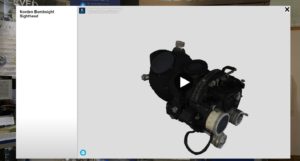 The last benefit (though it isn’t the final benefit, there are many more) is increased interpretation and education. Through virtual modeling, museums can explain and educate on a much deeper level because they can include more information online than they could on an exhibit sign. With our 3D models like the Norden bombsight, online visitors are able to zoom in closer to see what each dial does and how airmen used them. With our virtual tours, like the B-17, online visitors can learn the different roles of the crew, how they interacted with each other and how each member played a vital part in the success of a mission. Our education department can use the digital artifacts and aircraft in their lessons. Public school teachers can use them for their lessons as well.
The last benefit (though it isn’t the final benefit, there are many more) is increased interpretation and education. Through virtual modeling, museums can explain and educate on a much deeper level because they can include more information online than they could on an exhibit sign. With our 3D models like the Norden bombsight, online visitors are able to zoom in closer to see what each dial does and how airmen used them. With our virtual tours, like the B-17, online visitors can learn the different roles of the crew, how they interacted with each other and how each member played a vital part in the success of a mission. Our education department can use the digital artifacts and aircraft in their lessons. Public school teachers can use them for their lessons as well.
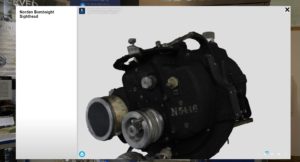 Hill Aerospace Museum will continue to offer our collections to the public in-person and now through digital formats. Since the release of the virtual tours of the B-17 Flying Fortress, C-140 JetStar, C-119 Flying Boxcar and the SR-71 Blackbird, Hill Aerospace Museum’s online audience has grown even larger! The mission of Hill Aerospace Museum is “to educate and inspire all ages through history, with a focus on the United States Air Force, Hill Air Force Base, Utah Aviation and unique learning experiences.” Those “unique learning experiences” now include digital collections and virtual tours. Hill Aerospace Museum plans to create virtual tours of all the aircraft in its collection. This is how Hill Aerospace Museum is embracing the future of a digital world.
Hill Aerospace Museum will continue to offer our collections to the public in-person and now through digital formats. Since the release of the virtual tours of the B-17 Flying Fortress, C-140 JetStar, C-119 Flying Boxcar and the SR-71 Blackbird, Hill Aerospace Museum’s online audience has grown even larger! The mission of Hill Aerospace Museum is “to educate and inspire all ages through history, with a focus on the United States Air Force, Hill Air Force Base, Utah Aviation and unique learning experiences.” Those “unique learning experiences” now include digital collections and virtual tours. Hill Aerospace Museum plans to create virtual tours of all the aircraft in its collection. This is how Hill Aerospace Museum is embracing the future of a digital world.
To check out the virtual tours, click here.
